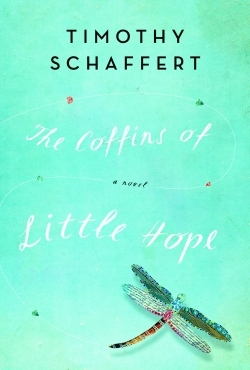The Coffins of Little Hope
One pleasure of this quirky, heartfelt novel is the feeling of being in direct conversation with the first-person narrator—an odd, spirited, and no-nonsense woman who speaks up even, one gets the sense, when she ought to know better.
At eighty-three years old, Ess is still writing obituaries for a once prosperous community newspaper run for generations by her Nebraska family. Her reluctant grandson, Doc, is now the publisher, an affable softie who’d rather be a magician. He’s keeping readers spellbound for now with aftermath accounts of the disappearance of a young girl who maybe didn’t exist after all.
As the county follows the sad and oddly compelling saga of the missing girl’s nymphet mother Daisy, Ess’s own family story unfolds. There is a daughter, Ivy, who six years before dropped everything, including her own young daughter, to live in Paris. When Ivy returns, reclaiming Tiff, now fourteen, from her brother Doc, who’d been raising the girl, Ess’s world begins to totter.
To keep the printing plant in operation, Doc secretly produces the final volume in an eleven-book young adult series, a global phenomenon that publishers want to keep from premature leaks. Though the entire town knows this secret, they also keep it.
Schaffert, author of three previous novels, plays with his reader a bit, but never for sport. His characters are baffling but evoke curiosity and compassion. Even their names intrigue: Reverend Most (mostly disliked); Tiff (“short for Tiffany,” who provokes, yet endears); Doc (not a professional anything); and Ess (whose byline is S Myles, “just S, no period,” and boils complex issues down to essentials).
Ess tries to help Doc cope with his unwanted job and losing Tiff, help Tiff adjust to an unexpected mother, and attempt to help the maybe-missing girl’s mother, Daisy, deal with paparazzi and cult-like celebrity. Meanwhile, she clandestinely corresponds with the unhappy author of the young adult book series, all the while coming to grips with a fast-approaching forced retirement and changes she’s still curious about in her family, newspaper, town, and life.
Whether the missing girl was real can be an initially distracting notion. But that aspect is less urgent than how her story embodies the need for the community, this one family, and the narrator to pull together, even as holes appear. At the same time, everyone must look outside themselves—not for answers, but for the questions which continue to bubble up, almost like magic.
Reviewed by
Lisa Romeo
Disclosure: This article is not an endorsement, but a review. The publisher of this book provided free copies of the book to have their book reviewed by a professional reviewer. No fee was paid by the publisher for this review. Foreword Reviews only recommends books that we love. Foreword Magazine, Inc. is disclosing this in accordance with the Federal Trade Commission’s 16 CFR, Part 255.

